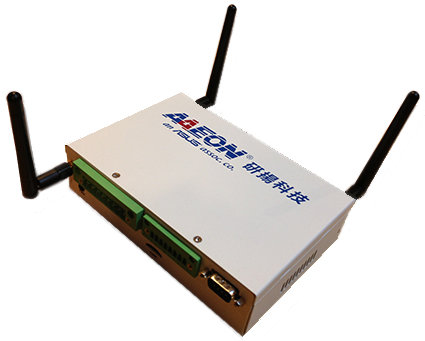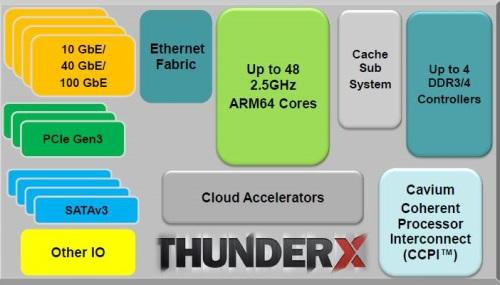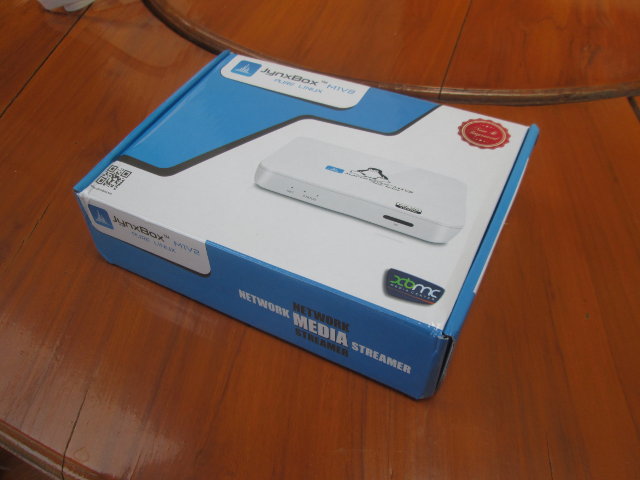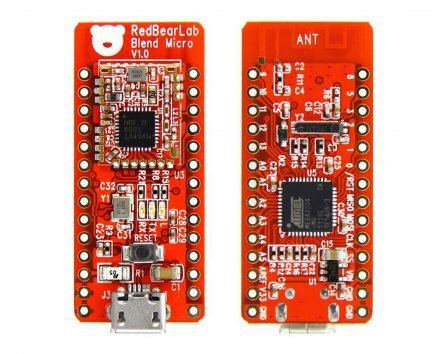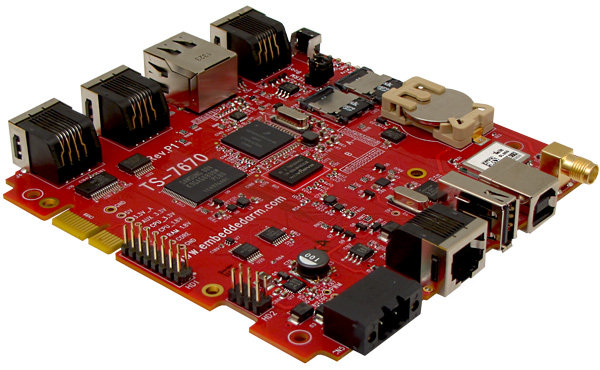Intel Quark SoC for low power embedded devices has been seen on platforms designed by Intel themselves, such as Intel Galileo board or Edison wearable development kit, but I had not found Quark SoC in actual products until Aaeon announced their AIOT-X1000 gateway for the internet of things running Linux on an Intel Quark X1000 SoC, and working with a Cloud Service by Asus, Aaeon’s parent company. The solution targets manufacturing, transportation, and energy applications. Aaeon AIOT-X1000 specifications: Processor – Intel Quark X1000-series SoCs @ up to 400 MHz System Memory – 1GB DDR3 800/1066 SODIMM Storage – IDE port, and micro SD slot Connectivity – 10/100M Ethernet USB 4x USB2.0 ports Serial – 1x RS-232/422/485, 1x RS-422/485 Other I/Os — I2C, GPIO, JTAG Mini-PCIe card expansion – 1x full-size and 1x half-size, allowing for WiFi, 2G/3G/LTE cellular, Bluetooth, CAN bus, ZigBee, and RFID add-on boards Power – 5V or 9-24V DC input Dimensions – 146 x […]
Cavium ThunderX Server SoC Features up to 48 ARM 64-bit Cores
ARM SBSA specification for server supports up to 268,435,456 CPU cores for the second level of standardization on one or a combination of SoCs. We’re not quite up there just yet, but Cavium ThunderX is an ARM server SoC with up to 48 cores on a single chip, which is the highest number of cores I’ve ever heard of in an ARM SoC. The company created their own custom processor cores using an ARMv8 architecture license, designing an SoC complies with ARM’s Server Base System Architecture (SBSA) standard with the following key features: ARM based SoC that scales up from 8 to 48 cores with up to 2.5 GHz core frequency with 78K I-Cache, 32K D-Cache, and 16MB L2 cache. Fully cache coherent across dual sockets using Cavium Coherent Processor Interconnect (CCPI) Integrated I/O capacity with 100s of Gigabits of I/O bandwidth 4x DDR3/4 72-bit memory controllers supporting up to 1TB RAM […]
Jynxbox M1V2 Pure Linux XBMC Media Player Review
Theaterinabox.tv has sent me Jynxbox M1V2 TV box running XBMC Linux Gotham 13.0, and powered by Amlogic AML8726-M3 processor @ 1 GHz with 2GB Flash and 1 GB RAM. This is an upgrade of the first version featuring AML872-M1 and 512 MB RAM. I’ll go through the specs first, then show some unboxing pictures and video, and complete this post by reviewing the device by playing videos from the network and a USB flash drive, as well as going through the available add-ons in a video review. Jynxbox M1V2/M1+ Specifications Here are the specifications listed for Jynxbox M1V2 Pure Linux, aka Jynxbox M1+: SoC – Amlogic AML8726-M3 @ 1GHz with Mali-400 GPU System Memory – 1GB RAM Storage – 2GB NAND flash + micro SD card reader (up to 32GB) Video & Audio Output – HDMI up to 1080p (default: 720p) Video Codecs & Containers- MPEG 1/2/4, H.264, X264, VC-1, WMV, M2TS, TS, RMVB, […]
Blend Micro Arduino Board Integrates Bluetooth 4.0 Low Energy Connectivity for 25 Euros
RedBearLab’s Blend Micro is an Arduino compatible board with Bluetooth 4.0 Low Enery (aka Bluetooth Smart) connectivity, that’s part of Arduino-at-heart, a partner program initiated by the developers of Arduino boards. It has been made to help design low power Internet-Of-Things (IoT) projects quickly and easily. Blend Micro technical specifications: MCU – Atmel ATmega32u4 @ 8 MHz with 32KB flash (4KB used by bootloader), 2.5 KB SRAM, and 1KB EEPROM. Connectivity – Bluetooth 4.0 Low Energy via Nordic nRF8001 chip USB – 1x micro USB port I/Os: Serial (Tx/Rx) I2C, SPI PWM U to 16 Digital I/Os Up to 6 Analog inputs Operating Voltage – 3.3V Input Voltage – 5V (USB), and 3.3-12V (VIN) Power Consumption – 2mA (average – using Interrupt mode) Dimensions – 43.6 x 18.4 x 4.3mm Weight – 4g The specs are very similar to BLEDuino, except it’s slightly smaller. Blend Micro can communicate with BLE […]
Linaro 14.05 Released with Linux Kernel 3.15, Android 4.4.2, and Ubuntu Trusty
Linaro 14.05 has been released with Linux Kernel 3.15-rc5 (baseline), Linux Kernel 3.10.40 (LSK), Android 4.4.2, and Ubuntu has been switched from Saucy to Trusty. More work has been done on big.LITTLE processing and ARMv8 support with notably completing bootstrapping with Debian 64-bit. New hardware platform have started to pop-up such as TI J6-Vayu which must be an evaluation board for Texas Instruments Jacinto 6 dual core Cortex A15 SoC for automotive application, as well as IFC6410, a Snapdragon 600 development board which got a Ubuntu LEB image. This month also marks the first release of Linaro GCC 4.9 toolchain. Here are the highlights of this release: Linux Linaro 3.15-rc5-2014.05 new Android topic (linaro-android-3.15-experimental) uses the resent AOSP code base GATOR version 5.18 (same version as in 2014.04) uprobes topic removed as all patches have been accepted into mainline updated big-LITTLE-pmu topic from ARM LT updated basic Capri board support […]
Technologic Systems TS-7670 Industrial Board Features Freescale i.MX286, Supports RAID-like System on SD Cards
Technologic Systems has unveiled an industrial board powered by Freescale i.MX286 ARM9 processor and a MCU part of NXP LPC1100 Cortex M0 series to to create a CDC ACM serial device on a host PC, and interfaces via UART, I2C, and SPI with the Freescale processor. The board targets applications such as fleet vehicle or asset tracking, point-of-sales (PoS), vending machines, data acquisition units, and data recorder modules. TS-7670 specifications: Processor – Freescale i.MX286 (1x ARM926EJ-S core @ up to 454MHz) MCU – NXP LPC Cortex M0 MCU in QFN32 package (LPC1114??) System Memory – 128MB to 256MB DDR2 RAM Storage – 2GB soldered NAND flash, 2x microSD slot with Doublestore support (similar RAID on SD card) Connectivity – 10/100 Ethernet port Wireless – Optional Telit Jupiter series multi-constellation GPS; optional CDMA, GPRS, or HSPA+ modules USB – USB host port, USB OTG port Other I/Os: 2x RS-232/interfaces (optional TTL […]
Prpl Non-Profit Organization to Work on Linux, Android, and OpenWRT for MIPS based Processors
In what looks like an answer, albeit fairly late, to Linaro, the non-profit organization working on open source software for ARM based SoCs, a consortium of companies composed of Imagination Technologies, Broadcom, Cavium, Lantiq, Qualcomm, Ingenic, and a few others, has funded Prpl (pronounced Purple), “an open-source, community-driven, collaborative, non-profit foundation targeting and supporting the MIPS architecture—and open to others—with a focus on enabling next-generation datacenter-to-device portable software and virtualized architectures”. The Prpl foundation will focus on three key objectives: Portability – To create ISA agnostic software for rapid deployment across multiple architecture Virtualization & security – To enable multi-tenant, secure, software, environments in datacenter, networking & storage, home, mobile and embedded Heterogeneous Computing – To leverage compute resources enabling next generation big data analytics and mining Initially there will PEG (Prpl Engineering Group) to take of the following projects for 4 market segments (datacenter, network & storage, connected consumers, […]
How to Upgrade Firmware for Rockchip RK3066, RK3188, RK3328, RK3288, RK3399 Devices with the Command Line in Linux
Previously I wrote an article entitled “How to Flash Rockchip RK3066 / RK3188 Firmware in Linux” explaining how to use a graphical tool called RkFlashKit to upgrade firmware on Rockchip devices using a Linux computer. This tool had some limitations, and it would just have a subset of features of RkAndroidTool (Windows), and it was not possible to flash “update.img” type of firmware which are often provided and flashed with RkBatchTool in Windows. Luckily there’s now a command line tool called upgrade_tool that allows you to flash the “update.img” firmware files directly from Linux. I’ve already shown how to use it with Radxa Rock, but it’s buried with other instructions, so I’ve decided to make a separate post. This has been tested in Ubuntu 14.04 with Radxa Rock (RK3188) and Measy U2C (RK3066). Ready? Let’s start by downloading and extracting upgrade_tool. You may want to add the installation path to […]


